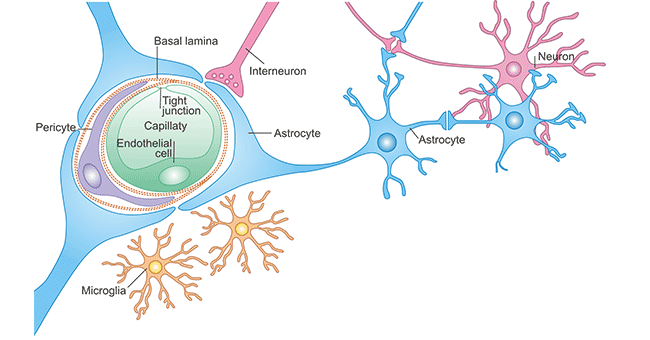The blood-brain barrier (BBB) is a critical structure in the central nervous system (CNS) that plays a pivotal role in maintaining a stable and controlled environment for the brain and spinal cord. The BBB acts as a selective filter, controlling the passage of substances between the blood and the brain, thus protecting neural tissue from potentially harmful compounds while allowing essential nutrients and gases to pass through. This selective permeability is vital for the proper functioning of the CNS, where delicate neural processes are easily disrupted by fluctuations in the chemical environment.
Structure and Formation of the Blood-Brain Barrier
The blood-brain barrier is formed by the endothelial cells that line the blood vessels in the brain. These endothelial cells are tightly joined by specialized junctions known as tight junctions, which prevent the free flow of substances between cells. Unlike other blood vessels in the body, the endothelial cells in the brain's blood vessels have fewer gaps, and the barrier is further reinforced by astrocytes—star-shaped glial cells that provide structural support to neurons. Astrocytic end-feet surround the blood vessels and contribute to the barrier’s formation and maintenance.
Additionally, the BBB is also supported by pericytes, contractile cells that wrap around endothelial cells, regulating blood flow and helping to maintain the integrity of the barrier.
Protective Functions of the Blood-Brain Barrier
- Selective Permeability: The primary function of the BBB is to maintain the brain’s internal environment by controlling which substances can cross from the bloodstream into the CNS. This barrier allows essential nutrients, such as glucose, oxygen, amino acids, and certain ions, to pass through via active transport mechanisms. However, it restricts the passage of harmful substances, including toxins, pathogens, and many drugs, which could damage sensitive neural tissue.
- Protection from Toxins and Pathogens: One of the most crucial roles of the BBB is to prevent the entry of harmful substances, such as toxins and pathogens (e.g., bacteria and viruses), from entering the brain and spinal cord. Since the brain is highly vulnerable to damage from these harmful agents, the BBB acts as a defensive wall that minimizes the risk of infection and injury to neural tissue. Inflammation or damage to the BBB can increase its permeability, leading to neurological conditions like meningitis or encephalitis.
- Regulation of Ion Balance: The brain requires a precise balance of ions (such as sodium, potassium, and calcium) to function properly. The BBB helps regulate the movement of these ions into the CNS to maintain homeostasis, which is vital for nerve signaling and brain function. Disruptions to this ion balance can result in neurological disorders, including seizures and other forms of neuronal dysfunction.
- Maintenance of the Brain's Chemical Environment: The brain’s neurons require a specific chemical environment to transmit signals efficiently. The BBB helps maintain this by preventing large molecules, hormones, and neurotransmitters in the bloodstream from crossing into the brain unless they are needed. This regulation ensures that the brain remains insulated from fluctuations in hormone levels, glucose, and other substances that could affect neural activity and cognition.
- Facilitating Waste Removal: The BBB also plays an important role in removing waste products from the brain. The brain relies on specialized systems, including the glymphatic system, to clear metabolic waste, such as amyloid-beta, a protein linked to Alzheimer's disease. Disruption of the BBB can impair this waste clearance process, leading to the accumulation of toxic substances in the brain, which could contribute to neurodegenerative diseases.
Limitations and Challenges
While the blood-brain barrier is essential for brain protection, it also poses a challenge for medical treatment. Many therapeutic agents, including antibiotics and cancer drugs, struggle to cross the BBB effectively. This limitation can make treating brain infections, tumors, or other CNS disorders particularly difficult. Researchers are working on developing methods to temporarily open the BBB or create drugs that can cross the barrier more efficiently, without compromising its protective functions.
Conclusion
In summary, the blood-brain barrier is a highly selective and crucial component of the central nervous system that protects the brain and spinal cord from harmful substances while allowing essential nutrients to pass through. By regulating the movement of ions, nutrients, and waste products, the BBB maintains the brain's chemical balance, safeguarding its delicate functions. However, its selective permeability also poses challenges for medical treatments targeting the CNS, making it a critical focus of ongoing research in neuroscience and medicine.
Subscribe on YouTube - NotesWorld
For PDF copy of Solved Assignment
Any University Assignment Solution


.webp)